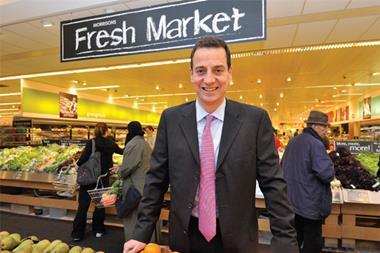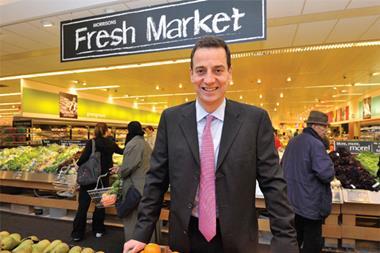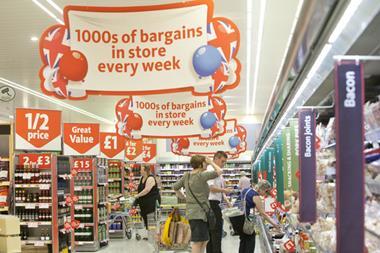Morrisons has high hopes for its simple, inexpensive new voucher scheme system. Analysts are distinctly underwhelmed…
By the end of this month, Morrisons will have rolled out a new checkout-based voucher scheme across its entire 476-strong store estate. It couldn’t come too soon.
A year after Sainsbury’s launched its award-wining Brand Match campaign, and more than two since the advent of the Asda Price Guarantee that spawned a whole new generation of voucher schemes, it’s taken time for these schemes to gain momentum, but as their popularity has grown, Morrisons has started to look distinctly old fashioned.
Of course, Morrisons has never been afraid to do its own thing. And it has recently criticised some of the discounting and vouchering activities of its rivals, while its dismissal of the need for a loyalty scheme dates back to prehistoric times.
But with the Bradford retailer performing so sluggishly since Christmas, will its foray prove a savvy dipping of the toe into the world of vouchers and loyalty? Or does it need to go further and become more aggressive in a bid to claw back some of the share it has been losing to rivals of late?
Initial reaction from industry observers has been underwhelming, not helped, perhaps, by a lack of real understanding of how the system - from marketing services company Catalina - actually works.
Unlike rival voucher-based schemes from Sainsbury’s and Asda, the Morrisons vouchers aren’t based on price comparison. They simply offer shoppers a voucher for money off their next shop, or money off major branded items. “Coupons will target the individual based on an analysis of the basket they are taking through the checkout,” says Morrisons head of media services Ben Hurley. “It is about rewarding customers with relevant and useful offers.”
And having conducted a trial of the system at 10 of its stores in the North East - well out of the way of most media and analysts - it clearly thinks the scheme has legs.
But Shore Capital analyst Clive Black does not believe vouchers alone will relieve its current pressures. “Morrisons seems to have been outmanoeuvred by the growth of vouchering amongst its peers and so has felt the need to join the fray,” he says. “It is reacting rather than setting the agenda on this matter.”
Investec’s Dave McCarthy is also unconvinced. “What it appears to have done with this voucher scheme is introduce a switching cost,” he explains. “It is trying to make it harder for shoppers to move to a rival as they will lose out on the vouchers if they do. At its simplest this is a low-cost, low-investment loyalty scheme.”
Sir Ken’s hoary influence
The loyalty of Morrisons shoppers has been paramount in commentators’ minds since founder Sir Ken Morrison attacked the current management during the retailer’s agm in June. He claimed the rollout of its Store of the Future concept - featuring exotic veg such as okra and samphire on steaming beds of ice to keep it fresh - risked alienating its core value-focused customers.
Black says there is some merit to this argument. “It is probably fair to say that Morrisons has not been on song with its marketing and value messages in recent times,” he says. “It has sought to encourage trading up just as the market started to go the other way. The business has disenfranchised core consumers and not attracted new ones.”
A big four rival also believes it is out of touch. “With such high wastage, the Store of the Future will never make money, and, like the M-Kitchen range, it has alienated its core M62-corridor constituency.”
Morrisons strenuously denies it is out of touch, however, pointing not only to the success of its M Savers range - which replaced Morrisons Value in January - and the value messaging that is plastered all over its new store layouts.
But the numbers continue to disappoint: last week figures from Kantar Worldpanel for the 12 weeks to 5 August showed Morrisons sales were up just 1.8% compared with 6.2% at Asda, Sainsbury’s 4.6% and Tesco’s 3.4%.
However, despite his criticism, Black stops short of recommending a more complete loyalty scheme. “Morrisons may need to extol its other points of difference. A fully-fledged loyalty scheme would be expensive but also me-too,” he suggests. “Good retailers do not need loyalty data to understand what their customers want.”
McCarthy agrees. “There are a lot of myths out there about loyalty cards,” he argues. “There are lots of other ways to find out what your customers want.”
And although Brand Match and APG have gained traction, vouchers may be a bit of a sideshow, he adds. “The trade is tough at the moment. Both Asda and Aldi are being very aggressive,” he explains. “Morrisons needs to be careful it doesn’t land a pyrrhic victory showing off these great new stores, but losing the war.”
Morrisons is set to report its half-year results on 6 September. For the past two years CEO Dalton Philips has mostly fielded questions about online. This time it’s all about the results.
What have Morrisons’ rivals done?
Asda Price Guarantee: Asda extended the APG in January 2011, promising that if it wasn’t 10% cheaper than rivals it would give shoppers back the difference. It’s widely believed to have been key to Asda’s fightback.
Brand Match: Sainsbury’s Brand Match was launched in October last year following a trial in Northern Ireland. It compares the price of branded products at Sainsbury’s against Tesco and Asda, if a customer spends more than £20. Vouchers are produced at the checkout.
Double The Difference: Tesco launched the promotion in February 2011. If shoppers found a product cheaper at Asda, Tesco would refund double the difference. Shoppers entered details of their receipt at home and were emailed a printable voucher. Tesco put a £20 cap on refunds a month later after savvy shoppers claimed vouchers up to £100 a time. By April it had dropped the ‘double’ and became plain old ‘just the difference’.


















No comments yet